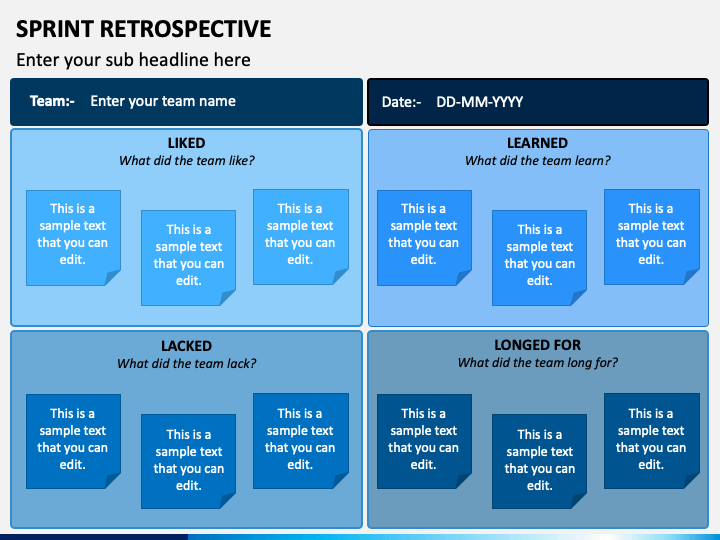
But for established teams, they can start to feel like a chore. Tell a Storyįor new teams, retrospectives can be exciting. You’ll look back at key events over a given time period, identify pain points, and develop action items to address them moving forward.


With this technique, you’re reflecting back on a longer period of time – not just on your most recent sprint.Ī timeline retrospective adds dimension to your retrospective meeting by incorporating the element of time. This format is especially helpful for multi-team, multi-sprint retrospectives. Use the SWOT Analysis Template in Miro> 7. Plot them on your whiteboard accordingly. Look back at your previous retrospective, identify its strengths and weaknesses, and pinpoint opportunities and threats that you can address in your next sprint. But maybe you’ve never thought about using it during a retrospective meeting. You’ve likely heard of a SWOT analysis before – it stands for strengths, weaknesses, opportunities, and threats. Less: Something that isn’t going as well, and you should do less of. More: Something that’s bringing value to the team, and you should do more of. Keep: Something the team is doing well and should continue doing.Īdd: Something new that the team should incorporate in the next sprint. You and your team will reflect on your previous sprint and generate ideas and observations to be placed on the board: With this retrospective technique, you’ll divide your whiteboard into four areas: keep, add, more, less. Use the sailboat retrospective template Miro> 5. They’ll jot their observations on sticky notes and place them accordingly on the picture of the sailboat that’s on your whiteboard – either on the sail (for wind) or below the boat (for anchors). Your agile team will compare your last sprint to a sailboat and identify what propelled it forward (like wind) and what held it back (like anchors). There’s nothing like a good metaphor to host an effective retrospective and keep your team engaged, and that’s exactly what the sailboat retrospective does. Like with most of the other retrospective ideas, you’ll need to group similar themes and decide which ones should be actioned on in your next sprint. Your team will brainstorm observations from your sprint that fall into the following five categories (like the five points of a starfish): This retrospective format challenges your development team to go beyond the surface of what went well and what didn’t. Use the 4 Ls Retrospective Template in Miro> 3. These seemingly simple questions can inspire a great conversation and reveal a lot of findings you can use to improve your next sprint. What did you like about your last sprint? What did you learn? What went wrong (meaning, what did you lack)? You get the idea. You and your scrum team will focus on one L at a time, and then brainstorm elements of the previous sprint that fit in that category. The four L’s stand for liked, learned, lacked, and longed for. This is another straightforward retrospective format that can be particularly enlightening. Use the Mad, Sad, Glad retrospective template in Miro. Then, they’ll place them in the appropriate section of the whiteboard based on how that observation makes them feel: mad, sad, or glad. Pinpointing our emotions can be powerful, and that’s exactly what this retrospective tool asks your agile team members to do.Įverybody will take time to write their observations about the last sprint on sticky notes (digital sticky notes work too!). Here are 10 different retrospective techniques you can use to boost engagement and enthusiasm during your sprint review. You want to switch things up for your next retrospective, but you aren’t sure where to start. 10 best sprint retrospective ideas to keep your team engaged But, when you use the same retrospective format time and time again, they’re far more likely to go on autopilot. Successful agile retrospectives require that your entire team is engaged in the conversation. Another 39% admit that they’ve even dozed off. Here are some scary statistics: 91% of employees admit that they’ve daydreamed during meetings. Same old sprint? Refresh with some new retrospective ideas Doing so will help your team glean new insights and build their agile muscles. To make the most of them, you should continue to incorporate new sprint retrospective ideas. The same concept applies to your retrospectives. Repeating your same stale routine means you’re never finding fresh ways to challenge yourself.

What happens after a while? Well, not only do you get bored (hey, we can’t blame you), but you also fail to take a well-rounded approach to fitness. But here’s the thing: Imagine that when you’re there, you do the exact same exercise over and over again – and only that exercise. You know that exercise is important, so you always make time to get to the gym.


 0 kommentar(er)
0 kommentar(er)
